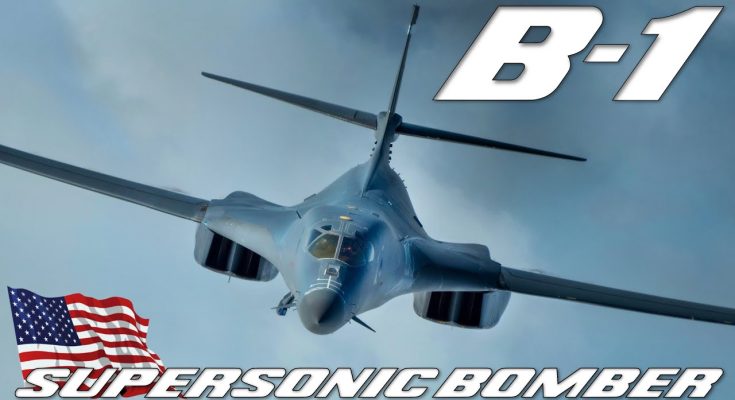The B-1 Lancer, one of the United States Air Force’s most iconic bombers, has long been a symbol of power and versatility. Known for its supersonic speed, long-range capabilities, and ability to deliver a variety of payloads, the B-1 Lancer plays a vital role in global military operations. One of the most stunning sights is watching this incredible aircraft in action, particularly during takeoff and landing maneuvers. Training footage of these events offers a glimpse into the precision and skill required to operate such a formidable machine.
Design and Capabilities of the B-1 Lancer
Before diving into the specifics of its training footage, it’s essential to understand the capabilities that make the B-1 Lancer so effective. Designed as a long-range strategic bomber, the B-1 can carry both conventional and nuclear weapons. It has a maximum speed of Mach 1.25 (about 1,500 mph or 2,400 km/h) and a range of over 6,000 miles (9,656 kilometers) without refueling. The B-1 can fly at extremely low altitudes, making it hard to detect by enemy radar, and its ability to carry large payloads makes it an integral part of the U.S. military’s strategic deterrence.
Takeoff: Power and Precision
The sight of the B-1 Lancer taking off is nothing short of breathtaking. As the aircraft accelerates down the runway, its distinctive variable-sweep wing design comes into play. The wings can change angles to optimize performance at different speeds, and during takeoff, they often appear extended. This allows for maximum lift, helping the bomber achieve the necessary altitude efficiently.
The engines roar to life with a deep, powerful sound as the B-1’s four F101 engines generate enough thrust to propel the aircraft into the sky. The jet’s sleek, aerodynamic body is visibly stretched forward as it picks up speed, and as it reaches takeoff speed, the B-1 lifts off with an impressive grace considering its size and weight. The twin-engine nacelle arrangement allows for faster, more efficient lift-off while maintaining its stealthy profile.
The takeoff is typically a coordinated event, with the aircrew managing numerous systems to ensure the bomber climbs steadily. Training footage highlights how pilots must handle the delicate balance between power and control, using complex flight systems to stay within operational parameters while ensuring maximum safety.
Landing: A Graceful Touchdown
Landing a B-1 Lancer is another incredible demonstration of precision and skill. Despite its heavy weight and massive payload capacity, the B-1 lands with a surprising degree of finesse. During landing, the bomber’s crew prepares for a steep descent, utilizing sophisticated flight control systems to guide the aircraft toward the runway.
The most striking part of the B-1’s landing is its use of airbrakes and drag chutes. As the bomber approaches the runway, the landing gear is deployed, and the aircraft slowly decelerates with the help of its extensive braking systems. The distinctive backward-swept wings also retract for optimal maneuverability during the approach. The B-1 approaches the runway at a relatively shallow angle to ensure a smooth landing while maintaining control over its descent.
The training footage often focuses on the final approach, where precision is essential. Pilots must adjust the aircraft’s speed, trajectory, and altitude in real-time, managing the controls as they prepare for the final touch. As the B-1’s wheels make contact with the runway, the aircraft’s large fuselage and advanced systems ensure that the bomber touches down smoothly, showcasing its design excellence.
Impressive Training Footage
Training footage of the B-1 Lancer in action provides a rare behind-the-scenes look at how the U.S. Air Force trains its personnel to handle such an advanced piece of military hardware. The visuals show the bomber’s impressive takeoff, flight, and landing sequences, highlighting not only the capabilities of the aircraft but also the skill and expertise of the pilots who fly it.
The footage captures various perspectives, from the aircraft’s exterior as it takes off, climbs, and performs complex maneuvers to the cockpit views that reveal the intricate control systems the crew operates during each phase of flight. For aviation enthusiasts and military observers, these videos showcase the B-1 Lancer as both a technological marvel and a crucial asset to U.S. military operations.
Conclusion
The B-1 Lancer is one of the most impressive aircraft in the U.S. Air Force’s fleet. From its powerful takeoff to its smooth, controlled landing, the bomber’s training footage provides a thrilling display of the skill, technology, and power that goes into every mission. It is a testament to the incredible engineering and precision that allows the B-1 to remain a force to be reckoned with in the skies. Watching these maneuvers in action is a stark reminder of the capabilities of modern military aviation.



